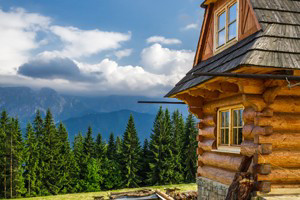Jackson Hole Wyoming Weather & Seasons
Jackson Hole experiences distinct seasonal weather patterns, making it a dynamic destination throughout the year. Visitors flock during the warm and bustling summer months, enjoy the quieter and still-summery September, brace for the unpredictability of fall, relish in the snowy winters, and witness the tranquil but sometimes muddy season of spring.
Summer
The busiest season in Jackson is the summer, particularly in July and August where visitors can enjoy temps between 70 and 90 degrees. September is still summery in temperature (besides cold nights), but is quieter.
Dates: June - August
Weather: Temperatures vary throughout the summer. On average summer nights are almost always cool, with temperatures ranging in the 40s, but getting considerably chilly in mountain locations. Daytime temperatures recover drastically from 70 to 90 degrees Fahrenheit. You can expect clouds to appear around noon and by mid-afternoon you may see scattered thundershowers.
Things to Do:
- Whitewater Rafting the Snake River
- Fishing
- Hiking
- Mountain Biking
- Horseback Riding
- Jackson Hole Rodeo
- Alpine Slide
- Music Festivals at Grand Targhee
- Chuckwagon
- Town Square Shootout
- Tram Ride at Teton Village
- Canoe, Kayak, or Paddle Board
- Golfing
Fall
The fall months, October and November, are unpredictable. Sometimes it snows in mid-October and sometimes the snow doesn't arrive until December.
Dates: September - October
Weather: Autumn in Wyoming is a delight. Many locations will see snow in mid-September, but it doesn’t get to be real winter until late November. During October and November, you’ll discover a warm Indian Summer, with cool nights and beautiful changing colors. Early freezes in the fall are common.
Things to Do:
- Horseback Riding
- Fishing
- Scenic Float
- Kayak, Canoe, or Paddle Board
- Biking
- Hiking
- Wildlife Viewing
- National Museum of Wildlife Art and Jackson Hole History Museum
- Fall Arts Festival
- Golfing
Winter
Winter runs from December through mid-April. It snows frequently and temps can range from 0 to 30 degrees.
Dates: November - March
Weather: Winters in Wyoming are usually long and cold. January is usually the coldest month of the year. At this time, the minimum temperatures are between 5 and 10 degrees. There are some mild periods when it gets up to the 50s. It gets colder in the western valleys – usually 5 degrees below zero. Snow falls often from November through March. Winter is a great time to visit Wyoming if you enjoy winter sports.
Things to Do:
- Skiing/Snowboarding at Jackson Hole Mountain Resort
- Skiing Grand Targhee
- Snow Tubing at Snow King
- Snowmobiling
- Snowshoeing or XC Skiing
- Dog Sled Ride to Granite Hot Springs
- Guided Backcountry Skiing
- Snowcoach Tours
- Elk Refuge Sleigh Ride
- Dining Out
Spring
Spring, from mid-April through May, is by far the most quiet season of the year. It's known as the mud season and many locals skip town for good reason.
Dates: April - May
Weather:
As the warm weather approaches, the flowers start to bloom, but early freezes and late winters are characteristic of spring in Wyoming. Always carry warm clothes and prepare for snow. Many locals leave during this time of year to escape the melt and you may find that businesses have limited hours.
Things to Do:
Questions & Answers
For outdoor adventures, it's good to come prepared in Jackson year-round for any adventure. It has famously snowed on Independence Day in Jackson Hole during the fireworks. Pack layers, as it can be hot and cold in the same day during the summer.
Around town, almost anything goes. Even the millionaires in Jackson tend to dress down for their time on the town. Denim pants or athletic wear are commonly seen, as is high-end Western chic apparel. Very few restauarants have a dress code, and even fewer enforce one. Even the most high-end restauarants call for "Jackson casual" or "dressy casual" wear, with the former translatable to nearly anything you want to wear.
Jackson Hole boasts year-round outdoor activities, but the options really open up in summer, fall, and winter.
In summer, visitors love the hiking, whitewater rafting, wildlife viewing, and access to the Tetons and Yellowstone.
In fall, you'll find that the crowds have died down and chill morning air is balanced by a radiant sun that still allows for deep access to the mountains. Wildlife is also in peak form going into fall, leading to numerous viewing opportunities.
Winter offers skiers, snowboarders, snowmobilers and other winter enthusiasts to play to their hearts' content. Jackson Hole Mountain Resort, Grand Targhee Resort and Snow King Mountain offern plenty of skiing options close to town.
Spring tends to be the quietest time of year in Jackson, largely because of iffy weather that can swing between bluebird spring days and dead-of-winter storms - sometimes in the same day. Spring skiing both at the resorts and in the backcountry can continue to be phenomenal, though avalanche danger can be high.

